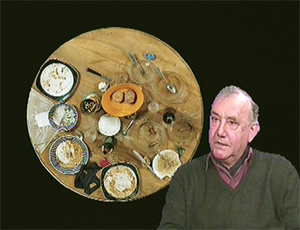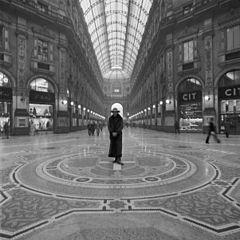
Fluxus was an international, interdisciplinary community of artists, composers, designers and poets during the 1960s and 1970s who engaged in experimental art performances which emphasized the artistic process over the finished product. Fluxus is known for experimental contributions to different artistic media and disciplines and for generating new art forms. These art forms include intermedia, a term coined by Fluxus artist Dick Higgins; conceptual art, first developed by Henry Flynt, an artist contentiously associated with Fluxus; and video art, first pioneered by Nam June Paik and Wolf Vostell. Dutch gallerist and art critic Harry Ruhé describes Fluxus as "the most radical and experimental art movement of the sixties".

Artists' books are works of art that utilize the form of the book. They are often published in small editions, though they are sometimes produced as one-of-a-kind objects.

Artist trading cards (ATCs) is a conceptual art project initiated by the Swiss artist M. Vänçi Stirnemann in 1997. He called it a Collaborative Cultural Performance. Artist trading cards are 2.5 by 3.5 inches in size, the same format as modern trading cards. They are self-made unique works or small series, signed and dated on the reverse by the artist/producer, exchanged and collected by the people who participate in the collaboration.
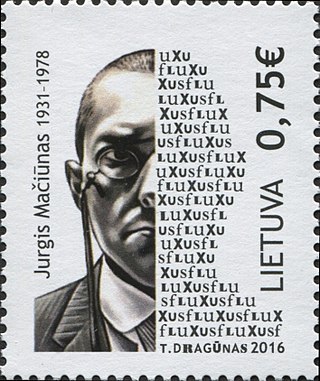
George Maciunas was a Lithuanian American artist, born in Kaunas. A founding member and the central coordinator of Fluxus, an international community of artists, architects, composers, and designers, he is most famous for organising and performing early happenings and for assembling a series of highly influential artists' multiples.

Neo-Dada was a movement with audio, visual and literary manifestations that had similarities in method or intent with earlier Dada artwork. It sought to close the gap between art and daily life, and was a combination of playfulness, iconoclasm, and appropriation. In the United States the term was popularized by Barbara Rose in the 1960s and refers primarily, although not exclusively, to work created in that and the preceding decade. There was also an international dimension to the movement, particularly in Japan and in Europe, serving as the foundation of Fluxus, Pop Art and Nouveau réalisme.

Nouveau réalisme is an artistic movement founded in 1960 by the art critic Pierre Restany and the painter Yves Klein during the first collective exposition in the Apollinaire gallery in Milan. Pierre Restany wrote the original manifesto for the group, titled the "Constitutive Declaration of New Realism," in April 1960, proclaiming, "Nouveau Réalisme—new ways of perceiving the real." This joint declaration was signed on 27 October 1960, in Yves Klein's workshop, by nine people: Yves Klein, Arman, Martial Raysse, Pierre Restany, Daniel Spoerri, Jean Tinguely and the Ultra-Lettrists, Francois Dufrêne, Raymond Hains, Jacques de la Villeglé; in 1961 these were joined by César, Mimmo Rotella, then Niki de Saint Phalle and Gérard Deschamps. The artist Christo showed with the group. It was dissolved in 1970.

Alison Knowles is an American visual artist known for her installations, performances, soundworks, and publications. Knowles was a founding member of the Fluxus movement, an international network of artists who aspired to merge different artistic media and disciplines. Criteria that have come to distinguish her work as an artist are the arena of performance, the indeterminacy of her event scores resulting in the deauthorization of the work, and the element of tactile participation. She graduated from Pratt Institute in New York with an honors degree in fine art. In May 2015, she was awarded an honorary doctorate degree by Pratt.

Arman was a French-born American artist. Born Armand Fernandez in Nice, France, Arman was a painter who moved from using objects for the ink or paint traces they leave to using them as the artworks themselves. He is best known for his Accumulations and destruction/recomposition of objects.

Assemblage is an artistic form or medium usually created on a defined substrate that consists of three-dimensional elements projecting out of or from the substrate. It is similar to collage, a two-dimensional medium. It is part of the visual arts and it typically uses found objects, but is not limited to these materials.

20th-century French art developed out of the Impressionism and Post-Impressionism that dominated French art at the end of the 19th century. The first half of the 20th century in France saw the even more revolutionary experiments of Cubism, Dada and Surrealism, artistic movements that would have a major impact on western, and eventually world, art. After World War II, while French artists explored such tendencies as Tachism, Fluxus and New realism, France's preeminence in the visual arts progressively became eclipsed by developments elsewhere.
Something Else Press was founded by Dick Higgins in 1963. It published many important Intermedia texts and artworks by such Fluxus artists as Higgins, Ray Johnson, Alison Knowles, Allan Kaprow, George Brecht, Daniel Spoerri, Robert Filliou, Al Hansen, John Cage, Emmett Williams and by such important modernist figures as Gertrude Stein, Henry Cowell, and Bern Porter.

Dieter Roth was a Swiss artist best known for his artist's books, editioned prints, sculptures, and works made of found materials, including rotting food stuffs. He was also known as Dieter Rot and Diter Rot.
Emmett Williams was an American poet and visual artist. He was married to British visual artist Ann Noël.
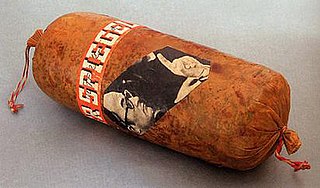
Literaturwurst is an Artist's book, made by the Swiss-German artist Dieter Roth between 1961 and 1974. Each book was made using traditional sausage recipes, but replacing the sausage meat with a book or magazine. The cover of the edition was then pasted onto the skin of the sausage and signed and dated.
'When I was young I wanted to become a real artist. Then I started doing something I felt wasn't real art, and it was through this that I became a well-known artist.' Dieter Roth
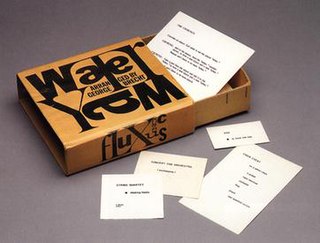
Water Yam is an artist's book by the American artist George Brecht. Originally published in Germany, June 1963 in a box designed by George Maciunas and typeset by Tomas Schmit, it has been re-published in various countries several times since. It is now considered one of the most influential artworks released by Fluxus, the internationalist avant-garde art movement active predominantly in the 1960s and '70s. The box, sometimes referred to as a Fluxbox or Fluxkit, contains a large number of small printed cards, containing instructions known as event-scores, or fluxscores. Typically open-ended, these scores, whether performed in public, private or left to the imagination, leave a lot of space for chance and indeterminancy, forcing a large degree of interpretation upon the performers and audience.
In some cases [event-scores] would arise out of the creation of the object, while in others the object was discovered and Brecht subsequently wrote a score for it, thus highlighting the relationship between language and perception. Or, in the words of the artist, "ensuring that the details of everyday life, the random constellations of objects that surround us, stop going unnoticed." The event-score was as much a critique of conventional artistic representation as it was a gesture of firm resistance against individual alienation.

Spice Chess is an artist's multiple by the Japanese artist Takako Saito, while she was resident in the United States. Originally manufactured winter 1964–65, and offered for sale March 1965, the work is one of a famous series of disrupted chess sets referred to as Fluxchess or Flux Chess, made for George Maciunas' Fluxshop at his Canal Street loft, SoHo, New York City and later through his Fluxus Mail-Order Warehouse.
"Takako Saito engaged with Duchamp's practice but also with masculinist cold war metaphors by taking up chess as a subject of [her] art. Saito's fluxchess works... question the primacy of vision to chess, along with notions of perception and in aesthetic experience more generally.... Her "Smell Chess," "Sound Chess" and "Weight Chess" reworked the game of chess so that players would be forced to hone non-visual perception, such as the olfactory sense, tactility, and aurality, in order to follow chess rules." Claudia Mesch
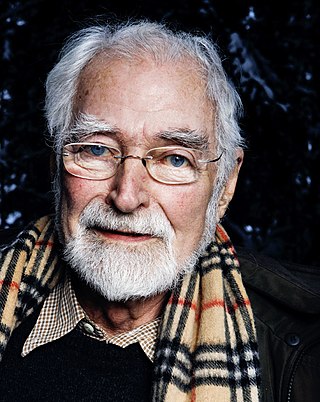
Knud Pedersen was a Danish artist and resistance leader. His career as a public figure started in 1942, when he and seven other young Danes founded the resistance group, Churchill Klubben. After the war, he worked briefly as a newspaper reporter, attended law school, and worked for a film company before devoting his life to art.

The Kunstmuseum Solothurn or Art Museum Solothurn is an art museum in the Swiss town Solothurn.
Laurence Whitfield is an English artist. He was a member of The Peterloo Group, and studied at Manchester Regional College of Art, now known as Manchester College of Arts and Technology (MANCAT).

Antje (-Maria) von Graevenitz, born Ludwig is a German art historian, art critic, educator and author.
